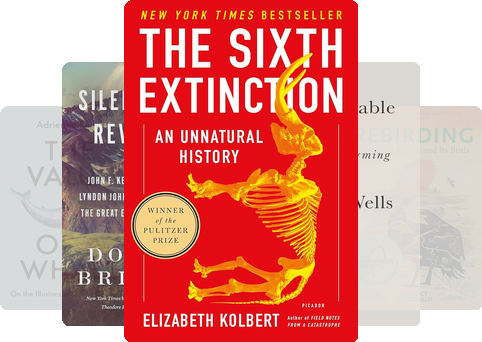Introduction to Earth Day 2025
Earth Day 2025 arrives amid escalating climate crises, from plastic pollution to biodiversity loss. This updated list features rigorous nonfiction books that dissect humanity’s impact on the planet, offering historical context, scientific analysis, and pragmatic solutions. These titles are essential for educators, activists, and policymakers seeking to deepen their understanding of ecological challenges and inspire tangible change.
Top Books About Earth’s Past, Present, and Future
“The Sixth Extinction: An Unnatural History” by Elizabeth Kolbert
Kolbert investigates the ongoing mass extinction driven by human activity, blending fieldwork with paleontological insights. She documents species loss from the Amazon to the Great Barrier Reef, revealing how industrialization, habitat destruction, and climate change are reshaping life on Earth. The book’s urgent tone underscores the need for immediate conservation action.
“Silent Spring Revolution” by Douglas Brinkley
Brinkley chronicles the 1960s environmental movement sparked by Rachel Carson’s Silent Spring, highlighting how activists, scientists, and politicians (including JFK and LBJ) catalyzed landmark policies like the Clean Air Act. This historical deep dive connects past advocacy to today’s climate battles, emphasizing the power of collective action.
“The Uninhabitable Earth: Life After Warming” by David Wallace-Wells
A harrowing yet meticulously researched projection of climate collapse, covering food shortages, economic destabilization, and ecosystem failures. Wallace-Wells balances grim realities with pragmatic solutions, urging systemic changes to avert worst-case scenarios.
“Rebirding: Rewilding Britain and Its Birds” by Benedict Macdonald
Macdonald critiques modern agriculture’s role in biodiversity loss and proposes rewilding strategies to restore bird populations. His solutions—from reducing sheep grazing to reforming subsidies—merge ecology with socioeconomics, offering a blueprint for habitat recovery.
“The Value of a Whale: On the Illusions of Green Capitalism” by Adrienne Buller
Buller dismantles flawed “solutions” like carbon offsets and green growth, arguing they perpetuate exploitation. She advocates for degrowth and equitable resource distribution, challenging readers to rethink economic systems driving environmental harm.
“Regenesis: Feeding the World Without Devouring the Planet” by George Monbiot
Monbiot exposes industrial agriculture’s devastation and champions regenerative farming, lab-grown food, and soil health. The book’s radical proposals aim to reconcile food security with ecological limits, stressing innovation over extraction.
“The Insect Crisis: The Fall of the Tiny Empires That Run the World” by Oliver Milman
Milman explores the alarming decline of insects, vital pollinators underpinning ecosystems. Through global case studies, he links pesticide use, climate change, and habitat loss to potential agricultural collapse—and profiles grassroots efforts to reverse the trend.
“Life on the Rocks: Building a Future for Coral Reefs” by Juli Berwald
Berwald follows scientists racing to save coral reefs from bleaching. Her narrative blends marine biology with human stories, showcasing restoration techniques like assisted evolution while underscoring reefs’ cultural and ecological significance.
“Under a White Sky: The Nature of the Future” by Elizabeth Kolbert
Kolbert examines geoengineering’s promises and perils, from carbon capture to gene-edited species. Her cautionary tales highlight humanity’s fraught attempts to “fix” nature, urging humility in technological interventions.
“The Future We Choose: Surviving the Climate Crisis” by Christiana Figueres & Tom Rivett-Carnac
Architects of the Paris Agreement outline two scenarios: a decarbonized 2050 vs. climate chaos. Their actionable steps—from political advocacy to corporate accountability—frame the crisis as a solvable challenge.
Conclusion
These books transcend doomism, offering rigorous analysis and hope. For educators, they provide lecture-ready content; for activists, evidence-based arguments; and for policymakers, scalable solutions. Pair them with Earth Day events like community rewilding projects or climate forums to bridge theory and action.
